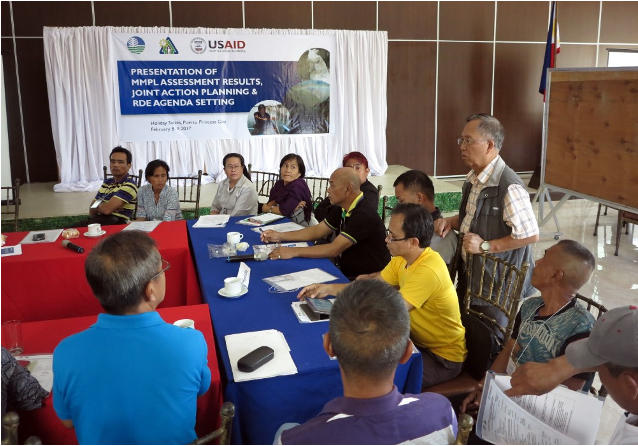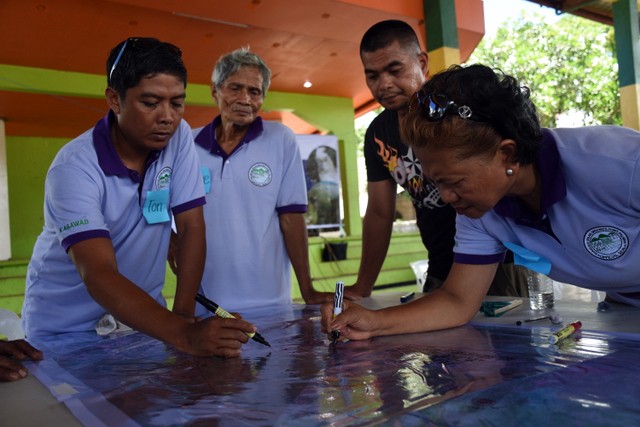Photo Credit: USAID Protect Wildlife
Integrated Conservation Planning and Implementation in the Mt. Mantalingahan Protected Landscape
Protecting Ecosystem Goods and Services (Honorable Mention 2020 Case Study Competition)
Protecting Ecosystem Goods and Services
Integrated Approach to Biodiversity Conservation in a Philippine Protected Area
by Randy Vinluan, USAID/Philippines Environment Office; Ernesto Guiang and Wilbur Dee, DAI Global/Philippines Protect Wildlife; Jeanne Tabangay, Conservation International Philippines
Seventy percent of forest cover is intact in the Mount Mantalingahan Protected Landscape in Palawan, the Philippines. This Landscape provides multiple ecosystem goods and services, including water services, food and medicine, fertile soils, wildlife habitat, and ecotourism opportunities. Indigenous peoples collect water use fees from downstream water users, which is used to support watershed conservation. Communities also receive 50 percent of tourist entrance fees from the protected area. These benefits amount to approximately US$1 million annually. However, undefined property rights have allowed encroachers and poachers to access forest lands and protected areas and resulted in mining activities, uncontrolled forest resource extraction, agricultural expansion, and wildlife poaching, all of which threaten biodiversity and pose a challenge to effective governance. This story describes how USAID/Philippines’s purposeful integration of biodiversity conservation, governance, and sustainable landscapes — activities that reduce greenhouse gas emissions from the land use sector — in the Protect Wildlife activity contributes to improved landscape management, local livelihoods, and human well-being, and offers lessons learned on designing and implementing an integrated approach.
During the country strategy and activity design process, USAID/Philippines’s leadership and technical staff felt a holistic, integrated approach and collaboration across sectors and government agencies would be the most effective way to address threats and drivers to biodiversity. USAID/Philippines developed a theory of change that integrated strategic actions and clarified areas for collaboration and coordination among team members. The mission then shared the theory of change in a series of meetings with national and local government and other stakeholders, a process that took approximately six months.
Empowering the local governments of five municipalities that straddle these forests and mountain range is a long-term and proven approach in addressing the threats to this conservation landscape.

One of the many scenic views when passing by Mount Mantalingahan Protected Landscape in southern Palawan. Despite being a mighty, rugged mountain range that spans five municipalities, Mount Mantalingahan and the many biodiverse habitats and species within it have to contend with old and emerging threats to its environment. Photo credit: USAID Protect Wildlife.
Protect Wildlife has continued to use its theory of change as a roadmap for integration, and staff regularly review whether to revise assumptions and adjust strategic actions. The mission and implementing partners deliberately schedule opportunities to reflect on the integrated approach, including through regular team meetings, quarterly team planning meetings, annual pause-and-reflect sessions, and stakeholder consultations. This consistent, participatory, and process-oriented approach to planning and implementation has facilitated consensus-building and deepened local ownership, resulting in increased support for integration and improved management of the Landscape.
Protect Wildlife uses a holistic approach to promote education and awareness of biodiversity conservation, support income-generating options for local communities, and contribute to strong enforcement of environmental laws to achieve sustainable alternative livelihoods and promote lasting behavior change. The integrated interventions in the Mount Mantalingahan Protected Landscape have increased local awareness and commitment to coordinate individual efforts to enforce biodiversity-related laws, integrate conservation land uses with local development strategies, and align investment support for production, infrastructure, and social services and assistance to upland farmers and indigenous peoples. Increased local awareness and participatory land use planning have culminated in the placement of over 260,641 hectares of biologically significant areas under improved management and the expectation of positive biodiversity conservation results.
Governance interventions have resulted in an active protected area management board that has updated the protected area management plan and forest use plans, and local communities are engaged in site-based wildlife law enforcement. Protect Wildlife’s capacity building on forestry, wildlife, and environmental law for community and government officials that operate in Mount Mantalingahan Protected Landscape has resulted in 124 reported confiscations, seizures, and arrests related to illegal logging and fishing and wildlife trafficking, contributing to reduced environmental and wildlife crime. In addition, sustainable landscapes activities have resulted in 610,603 metric tons of carbon dioxide equivalent reduced, sequestered, or avoided, and the activity anticipates an increased reduction in the future as a result of improved management of mangroves and planned forest restoration activities.
Lessons Learned:
Integrate Purposely
Start with a situation model and robust theory of change when adopting an integrated approach. Use a robust theory of change to show how integrating various interventions, usually in different sectors, contributes to a common result. Use a collaborating, learning, and adapting (CLA) approach to adjust, modify, or even completely abandon planned activities over time as intermediate results come in.
Integrate from the Start
Communicate the theory of change to stakeholders as early as possible to increase understanding of the activity from the beginning. Engage with stakeholders early to facilitate buy-in of the integrated approach and increase understanding of the roles and responsibilities of different stakeholder groups. Reflect assumptions in the theory of change.
Engage Stakeholders and Encourage Participation
Work with local stakeholders and employ participatory processes as these are key to the success of an integrated approach. The buy-in of local governments, national government agencies, and communities is critical, especially in adopting policy-consistent and technically-sound land uses, enforcing wildlife laws and zoning ordinances, and directing livelihood and infrastructure support for the marginalized upland communities and indigenous peoples.
Integrate Together
Define team members’ unique roles and their contributions to achieving activity objectives. Designate a person, or a group of persons, that coordinates all integration efforts. Remain open to learning from team members during planning and implementation. Share knowledge and lessons with each other and collectively reflect on necessary actions to achieve integration objectives.
Download document(s)
Case Study in English
Case Study in Spanish
Download CS
The Conservation Standards is the product of inputs, field tests, and discussions among members of the Conservation Measures Partnership (CMP), which has final editorial authority over the Conservation Standards. Substantial input was also provided by members of the Conservation Coaches Network (CCNet) and other CMP partners.
Photo Credit: Felix Cybulla
Support CS
The biodiversity conservation community is tackling large, complex, and urgent environmental problems where the stakes are high. However, we don’t have a fully functional system to assess the effectiveness of our actions. Without more rigorous measurement of effectiveness and disciplined recording of our efforts, we cannot know or demonstrate that we are achieving desired results.
Photo Credit: Felix Cybulla
Our Collaborators
Every organization, agency, project, and individual has its own preferred set of terms. There is no right answer – the most important thing is that the members of your project team and the people with whom you work have a clear and common understanding of whatever terms you choose to use.
Photo Credit: Chris Scarffe
Contact Us
To inquire about supporting Conservation Standards (CS) or for general inquiries, please contact us at CMPinfo@ConservationMeasures.org
Photo Credit: Nature Conservancy of Canada


